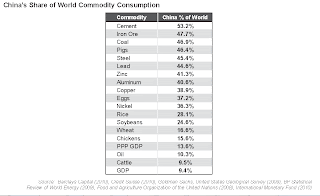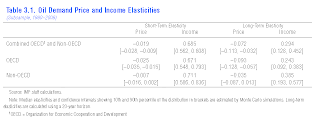The International Monetary Fund's
World Economic Outlook has a discussion of energy security (chapter three). The main conclusions:
The persistent increase in oil prices over the past decade suggests that global oil markets have entered a period of increased scarcity. Given the expected rapid growth in oil demand in emerging market economies and a downshift in the trend growth of oil supply, a return to abundance is unlikely in the near term. This chapter suggests that gradual and moderate increases in oil scarcity may not present a major constraint on global growth in the medium to long term, although the wealth transfer from oil importers to exporters would increase capital flows and widen current account imbalances. Adverse effects could be much larger, depending on the extent and evolution of oil scarcity and the ability of the world economy to cope with increased scarcity. Sudden surges in oil prices could trigger large global output losses, redistribution, and sectoral shifts. There are two broad areas for policy action. First, given the potential for unexpected increases in the scarcity of oil and other resources, policymakers should review whether the current policy frameworks facilitate adjustment to unexpected changes in oil scarcity. Second, consideration should be given to policies aimed at lowering the risk of oil scarcity.
Perhaps the most surprising conclusion is the remarkably low price elasticities estimated for oil consumption. (Elasticity refers to how people respond to prices. A low number, as below, means that they keep buying the product regardless. A high number means that they cut back.)

The combined results for OECD and Non-OECD countries suggest very low short-term price elasticity, about –0.02 (Table 3.1). This implies that a 10 percent increase in oil prices leads to a reduction in oil demand of only 0.2 percent. Although the long-term price elasticity is about four times larger, the number is still small, which implies that a 10 percent permanent increase in oil prices reduces oil demand by about 0.7 percent after 20 years.
Income elasticity measures the effect on the consumption of a given product assuming an increase in income. A high number, as below, means that consumption rises in parallel with income.
The short-term income elasticity is about 0.68, implying that a 1 percent increase in income is associated with an increase in oil demand of 0.68 percent. The long-term elasticity is considerably smaller, at 0.29. This result indicates that oil consumption has been considerably less income-elastic than primary energy demand, which means that the world economy has been (slowly) substituting away from oil. In addition, the fact that income elasticity is higher in the short term than in the long term suggests that the response of oil consumption to an income shock involves some cyclical overshooting.
Initial responses, such as those during the global recovery of 2009–10, therefore may not be representative of longer-term trends. The growing importance of emerging market economies appears to have reduced world oil demand price elasticity (in absolute terms) and increased income elasticity. . . .
The
Early Warning blog comments on the incredibly low elasticities projected by the IMF:
I've tended to be an inelasticity hawk, but these numbers are really eye-popping. -0.007 for emerging market oil price inelasticity! That implies a 10% increase in oil prices produces a negligible 0.07% decrease in consumption. That's the short term number, but even the 20 year horizon is only -0.035. Meanwhile, short term global income elasticity is 2/3. So that 4% economic growth requires 2 1/3% annual increases in oil production to keep prices stable. . . .
Note that these IMF estimates are based on the 1990-2009 interval. This was a period of generally low oil prices, except for a single price spike from 2005-2008 or so, and very widespread access to credit in developed countries.
Access to credit is now more constrained, forcing some people to economize, rather than being in a position to borrow in order to bid prices of perceived necessities higher. This will make demand more elastic.
Adaptation as a result of the 2005-2008 price spike was very limited (eg the impact on the US fuel economy averages was quite subdued). Experience from the 1970s was that the really big changes came after the second shock (in 1979/1980), rather than the first (in 1973/74). It may work the same way now.
In particular, if oil prices go high enough, often enough, we would expect that to trigger large scale switching of transportation options to plugin-hybrids, compressed natural gas, etc. It will also promote more use of smaller cars, scooters, electric bicycles, etc.
For all these reasons, I expect elasticities in the next twenty years to be higher than in the last twenty.
Given these tiny reductions in demand stemming from increases in price, the implications of a decline in energy production are pretty startling. Early Warning (Staniford) notes that it basically fractures the models and goes on to cite the IMF's speculations on what declining supply would mean for price:
Another alternative scenario considers the implications of a more pessimistic assumption for the declines in world oil output—3.8 percent rather than 1 percent annually—accompanied by a 4 percent annual increase in real extraction costs per barrel rather than 2 percent (Figure 3.11). This implies that, barring any increase due to the supply response to higher prices, oil production declines by 2 percent annually—a scenario that reflects the concerns of peak oil proponents, who argue that oil supplies have already peaked and will decline rapidly.30 In this scenario, the longer-term output and current account effects are roughly three to four times as large as in the benchmark scenario, meaning they increase roughly in proportion to the size of the shock. Declines in absorption in oil importers are now on the order of 1.25 to 3 percent annually over the period shown, while in oil exporters, domestic absorption increases by more than 6 percent annu- ally. Current account deterioration in oil importers is also much more serious, averaging 6 to 8 percentage points of GDP over the long term.
The most striking aspect of this scenario is, however, that supply reductions of this magnitude would require an increase of more than 200 percent in the oil price on impact and an 800 percent increase over 20 years. Relative price changes of this magnitude would be unprecedented and would likely have nonlinear effects on activity that the model does not adequately capture.
A few days later,
Early Warning commented further on the curious assumptions in the IMF report. Over the next five years, the IMF projects a world growth rate of 4.5% a year. If, as the IMF assumes, the income elasticity for oil is .685, that means that consumption would grow at 68% of the overall world growth rate, or about 3% a year. EW shows, graphically, what that would mean:
As EW comments, such growth seems very unlikely. The red line in the graph, based on the IMF projection of a .685 income elasticity
requires the world come up with another 17mbd of supply in the next five years, though it only managed to come up with about 3-4mbd over the last five years, and that took a quadrupling of prices to achieve. I don't see where this much oil can possibly come from. Saudi Arabia is saying they aren't going to increase production much if at all in the next five years. Russia is pretty much plateaued. The US is long past peak, and will be lucky to avoid further declines. Iraq is the one hope for truly large increases in oil supply, but that increase has just barely started, and is not going to amount to more than a few mbd over the next five years.
The green curve looks at what happens if you say that oil prices will not be constant, but instead will increase by enough to make supply grow at 1% less per year than the red curve. That way we only need another 11mbd, instead of 17mbd. That's still an implausibly large amount of oil. But even that causes huge problems if we take seriously the short term price elasticity of -0.019 in the IMF's table 3.1 above. That means that to reduce supply by 1%, we need to increase price by 1/0.019 = 53%. Each year. As you might imagine, prices rise to ludicrous heights in no time:

The conclusion? There is no way to square the IMF's projection of world economic growth with its projection of the effect of such growth on oil prices or consumption. Instead, economic growth produces a startling increase in oil prices, which in turn induces recession. That brings oil prices down, temporarily, but the constraints on oil supply operate, over time, as a fundamental constraint on economic growth. If oil supply remains flat or grows slowly, there is an immense challenge in improving the efficiency with which the world's economies use oil. Given enormous fixed investments in the transportation sector, where most of the oil is used, that can't be done overnight. Reducing oil usage, under those circumstances, requires a contraction of economic activity. In the medium to longer term, undoubtedly, much greater efficiencies are possible. People buy more fuel efficient cars or move closer to their place of employment. There is, however, little evidence that most governments--certainly not the American government!--will anticipate these constraints. They will change when they are forced to change, after being hit over the head with a two-by-four, not before.








